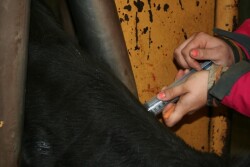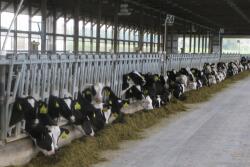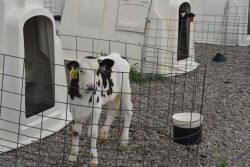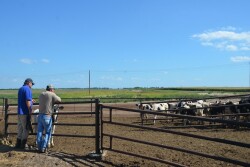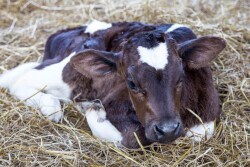Bovine Respiratory Disease
A trusted adjuvant can make all the difference in capturing a strong immune response in young calves.
Direct sampling of the lower respiratory tract can sharpen bovine respiratory disease diagnosis, improve case management and support antimicrobial stewardship.
A comprehensive herd-health program is crucial for the management and prevention of bovine respiratory disease.
K-State veterinarian Bob Larson says 3% to 5% of calves suffer from pnemonia each year.
Looking at Mycoplasma Bovis in beef herds including a calf’s environment and vaccination program.
Experts at Kansas State University’s Beef Cattle Institute share guidelines for tracking herd health.
Limiting stress and maintaining a strong relationship with a veterinarian are vital for an Oklahoma rancher’s success in fighting disease issues.
The minute a newborn calf hits the ground, its surrounding environment can impact its future health. A multi-phase study from the University of California-Davis teases out the finer points of maternity pen management.
When dairy farmers think about animals impacted by cold stress, calves are often the first that come to mind. However, it’s important to remember that cold stress doesn’t just affect calves—it can also significantly impact heifers.
Vigilance with vaccination protocols and calf management can help prevent BRD on the dairy.
USDA announced on Oct. 30 the first reported case of H5N1 in a pig in an Oregon backyard farm.
The study also showed that a bovine H5N1 virus is susceptible to the antiviral drugs favipiravir and baloxavir marboxil (brand name Xofluza) of the polymerase inhibitor class, as well as the neuraminidase inhibitor zanamivir.
Among the mix of technologies, management factors, and strategies to raise healthy calves: genetics. There is growing evidence that calves can inherit the ability to resist calfhood diseases like pneumonia and scours from their parents.
Dr. Brad White is building a multi-disciplinary team to research the issue. The team will sample over 2,400 cattle in Kansas and Texas as part of their work.
A team at K-State has been chosen by the World Organisation of Animal Health to lead an international effort that will develop decision-making tools and improve communication on the economic impacts of animal diseases.
Between 60% and 70% of U.S. dairies have mycoplasma at least as a component of the respiratory disease that they deal with, according to Geof Smith, DVM and a dairy technical services veterinarian with Zoetis.
Zelnate DNA Immunostimulant is used to treat respiratory disease due to Mannheimia haemolytica. The label recommends use at or within 24 hours after a perceived stressful event in cattle 4 months of age and older.
Drs. Grant Dewell and Mike Apley, respectively, and Extension nutritionist Paul Beck weigh in on some things they believe contribute to the disease and how you can stem its development from the farm to the feedlot.
While vaccination is widely considered a critical component of cattle health management, could the timing of vaccination impact the efficiency of the product?
SpectoGard (spectinomycin sulfate) sterile solution—which received FDA approval in September of 2022—is now available for veterinarians and cattle producers in the United States.
We can’t control everything on a cattle operation. But we can make a battle plan to protect calves from bovine respiratory disease long before we ever reach for antibiotics.
The Texas A&M AgriLife research could revolutionize antimicrobial treatment in commercial beef production.
Detecting respiratory disease in calves early – when treatment is most effective – should start by examining the head and facial features, according to veterinarian Tiago Tomazi with Merck Animal Health.
This is a ready-to-use injectable solution containing 100 mg of tulathromycin/mL, a trusted antibiotic to treat and control BRD, foot rot and pinkeye in cattle, as well as swine respiratory disease.
In the past, it was believed there was no point to give injectable respiratory vaccines before about 4 months of age, because they would be inactivated by maternal antibodies. A recent study proves that’s not the case.
Every re-treatment puts additional stress on calves and reduces profit margins due to the additional medicine and labor costs. On the other hand, waiting too long to re-treat can increase the number of sick calves.
Kansas State College of Veterinary Medicine researchers addressed this important question in a recent study. Dr. Miriam Martin summarized the study results and what the team learned for Bovine Veterinarian readers.



